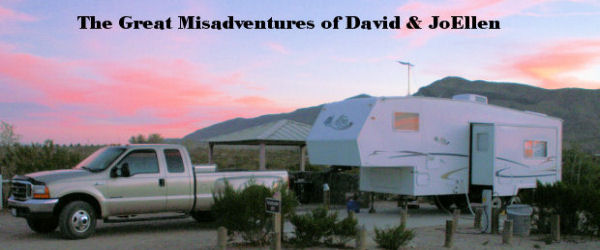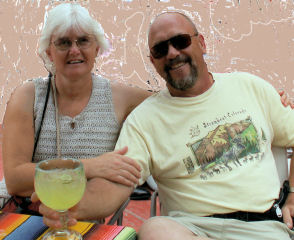
Avoid the snow, Part III
10/02/07 through 10/28/07
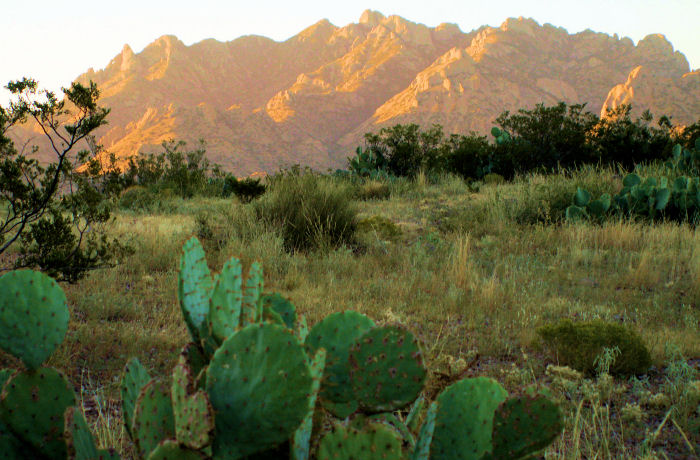
The Florida Mountains at sunrise. View from campsite at Rockhound State Park, Deming, New Mexico
Here it is, our third adventure away from the snow and cold of the winter seasons previously endured in the Colorado Rockies. We leave Westcliffe on Tuesday, October 2nd, to start the slow journey into the desert southwest. This trip, we will be joined by Bill and Stella, JoEllen's parents, for the drive through New Mexico staying at the state parks along the way. Also new this trip, David purchased a trailer for his ATV and we are towing it behind the 5th wheeler to enjoy in the desert areas of Quartzsite, Arizona this winter.

|
|
Departing view of the Sangre de Christo Mountains.
|
After stopping for a new air conditioner for the 5th wheeler (hail damage) in Pueblo, Colorado, we travel to Las Vegas, New Mexico spending a night at Storrie Lake State Park. We continue south on I-25 to Elephant Butte State Park for 6 nights, then south to Percha Dam State Park for another 5 nights. During our stay here, we travel up Emery Pass and visit the towns of Hillsboro and Kingston enjoying the beautiful landscape.
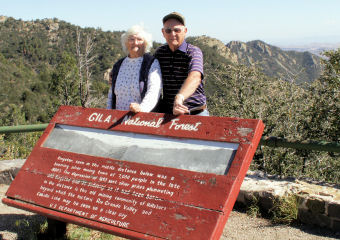
|
|
Bill and Stella at the summit of Emery Pass.
|
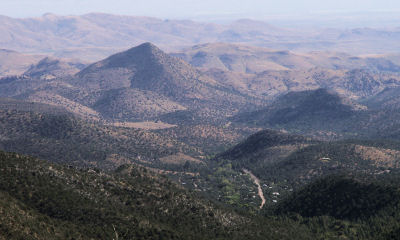
|
|
View at the summit, Kingston located at lower right.
|
 A quick stop at Leasburg Dam State Park outside of Las Cruces is our next stop. Campsites are only available for one night, so we visit our favorite used bookstore, COAS My Bookstore, browsing the many books and celebrate JoEllen's 49th birthday at our number one Mexican Restaurant, La Posta de Mesilla. (great food and terrific margaritas!)
A quick stop at Leasburg Dam State Park outside of Las Cruces is our next stop. Campsites are only available for one night, so we visit our favorite used bookstore, COAS My Bookstore, browsing the many books and celebrate JoEllen's 49th birthday at our number one Mexican Restaurant, La Posta de Mesilla. (great food and terrific margaritas!)
Deming, New Mexico
10/15/07 through 10/29/07
We travel west now to Deming, New Mexico, staying at Rockhound State Park. This is one of our favorite stops on previous MisAdventures as there are gorgeous views, nice hiking, and awesome sunsets to be viewed from our camp, located at the base of the Little Florida Mountains with the rugged north side of the Florida Mountains across the valley. We are camped here for 2 weeks. Bill and Stella lived just down the road in the 70's at Columbus, so this is kind of like a homecoming.
The first known inhabitants of this area were the Mimbres Indians. They lived and farmed along the Mimbres River. The Mimbres Indians are best remembered today for their beautiful pottery. There are many fine examples of their work at the Deming Luna Mimbres Museum.
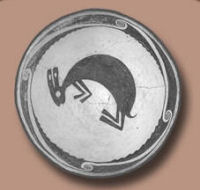
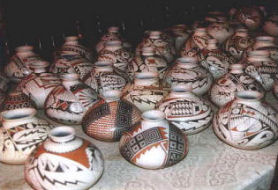
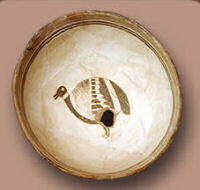
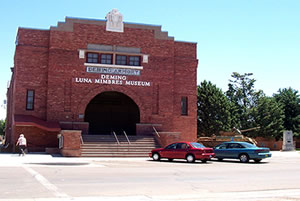 The Museum was originally the National Guard Armory. The museum's unique story began early in the century when military troops slept in the unfinished building as recruitment proceeded for U.S. defense of the U.S./Mexico border. It was completed two months after the infamous Pancho Villa Raid on March 9, 1916, at Columbus. It later served both as a community center and USO activity center for military personnel stationed in the area. Today, the Museum has a huge collection of exhibits, including quilts dating back to 1847, Native American artifacts, arts, military artifacts and exhibits, over 1200 historic liquor decanters, an exhibit containing over 2500 bells, and a doll room.
The Museum was originally the National Guard Armory. The museum's unique story began early in the century when military troops slept in the unfinished building as recruitment proceeded for U.S. defense of the U.S./Mexico border. It was completed two months after the infamous Pancho Villa Raid on March 9, 1916, at Columbus. It later served both as a community center and USO activity center for military personnel stationed in the area. Today, the Museum has a huge collection of exhibits, including quilts dating back to 1847, Native American artifacts, arts, military artifacts and exhibits, over 1200 historic liquor decanters, an exhibit containing over 2500 bells, and a doll room.
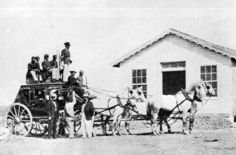 It was around 1800 when settlers began arriving in southwest NM. In its early years the area had a bad reputation. It is said that outlaws rounded up in Arizona were given a one way ticket to here. Mid century, the Butterfield Trail Stage had a stop nearby. Present day Interstate 10 across New Mexico and Interstate 8 west of Tucson, Arizona somewhat follow the route of the old stageline.
It was around 1800 when settlers began arriving in southwest NM. In its early years the area had a bad reputation. It is said that outlaws rounded up in Arizona were given a one way ticket to here. Mid century, the Butterfield Trail Stage had a stop nearby. Present day Interstate 10 across New Mexico and Interstate 8 west of Tucson, Arizona somewhat follow the route of the old stageline.
 In late 1881, the Southern Pacific RR, building toward the west, reached this point and a tent and shanty city soon followed. It was named Deming after Mary Deming Crocker, the wife of a Southern Pacific RR executive. Six months later the Atchison, Topeka and Santa Fe RR lines arrived in town and Deming became an important community in the early history of southwest NM. Settlers flocked in, buildings were erected, stores and businesses were established and
through the years Deming continued to grow.
In late 1881, the Southern Pacific RR, building toward the west, reached this point and a tent and shanty city soon followed. It was named Deming after Mary Deming Crocker, the wife of a Southern Pacific RR executive. Six months later the Atchison, Topeka and Santa Fe RR lines arrived in town and Deming became an important community in the early history of southwest NM. Settlers flocked in, buildings were erected, stores and businesses were established and
through the years Deming continued to grow.
Following WW I Deming, like much of the nation, saw its' economy decline. Both of the banks in town closed their doors. Recovery was slow. WW II brought new growth to the area. An Army Air Force Base for training bombardiers was established in Deming. More than 5,000 men were stationed at the base. The Deming National Guard was called into service and sent to the Philipines. Several of these brave men lost their lives in the Bataan death march. Others remained prisoners of war until 1945. Deming recently opened a new public school which was named Bataan to honor those National Guardsmen.
 Deming, county seat of Luna County, has continued to grow through the years since WW II. It is currently home to approximately 14,000 people. The annual Deming Duck Races, held in late August, is an event we have yet to see.
Deming, county seat of Luna County, has continued to grow through the years since WW II. It is currently home to approximately 14,000 people. The annual Deming Duck Races, held in late August, is an event we have yet to see.
Rockhound State Park
10/15/07 through 10/29/07
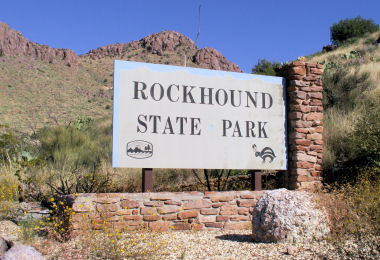 Rockhound State Park lies in the Little Florida (Floor-EE-dah) Mountains southeast of Deming. It was established in 1966 as the first park in the United States that allowed collecting of rocks and minerals for personal use. Each visitor is allowed to collect as much as 15 lb of rocks and minerals from the 1,100-acre park. Rockhound State Park actually consists of two separate units, the main park and Spring Canyon Recreation Area. Spring Canyon lies in the northern Florida Mountains, south of the main park, and is open for day use only from Easter through November.
Rockhound State Park lies in the Little Florida (Floor-EE-dah) Mountains southeast of Deming. It was established in 1966 as the first park in the United States that allowed collecting of rocks and minerals for personal use. Each visitor is allowed to collect as much as 15 lb of rocks and minerals from the 1,100-acre park. Rockhound State Park actually consists of two separate units, the main park and Spring Canyon Recreation Area. Spring Canyon lies in the northern Florida Mountains, south of the main park, and is open for day use only from Easter through November.
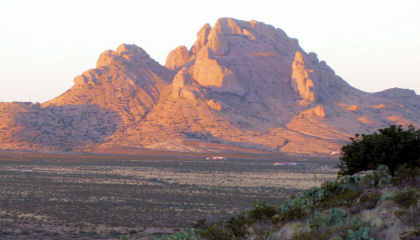 The main park provides excellent views of the surrounding mountain desert. Basin and range topography is easily seen in the distance. On a clear day the smokestacks of the Hurley smelter can be seen to the northwest. The Cobre Mountains form the far northern horizon behind the smokestacks. The Burro Mountains lie to the west-northwest; the Victorio Mountains lie to the west-southwest. The Florida Mountains lie directly to the south of the main state park. The Cedar Mountains lie to the south-southwest. The dark mountain north of Deming is called Black Mountain.
The main park provides excellent views of the surrounding mountain desert. Basin and range topography is easily seen in the distance. On a clear day the smokestacks of the Hurley smelter can be seen to the northwest. The Cobre Mountains form the far northern horizon behind the smokestacks. The Burro Mountains lie to the west-northwest; the Victorio Mountains lie to the west-southwest. The Florida Mountains lie directly to the south of the main state park. The Cedar Mountains lie to the south-southwest. The dark mountain north of Deming is called Black Mountain.
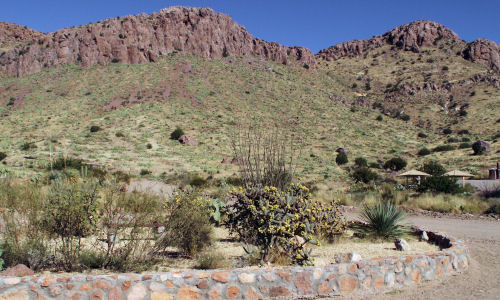
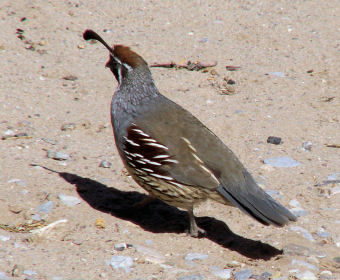
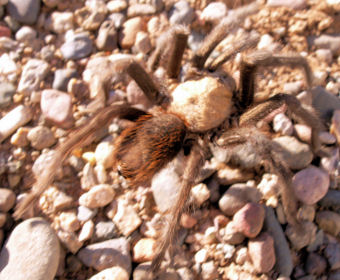 The Florida and Little Florida Mountains are typical of the mountain desert throughout southern New Mexico and Arizona. Elevations range from 4,400 ft along the foothills, where the state park is located, to 7,448 ft at Florida Peak in the Florida Mountains. Water is scarce and limited to wells and hidden
springs, but despite the dry, seemingly inhospitable environment, life abounds. The area is home to many lizards and snakes, deer, antelope, coyotes, and
The Florida and Little Florida Mountains are typical of the mountain desert throughout southern New Mexico and Arizona. Elevations range from 4,400 ft along the foothills, where the state park is located, to 7,448 ft at Florida Peak in the Florida Mountains. Water is scarce and limited to wells and hidden
springs, but despite the dry, seemingly inhospitable environment, life abounds. The area is home to many lizards and snakes, deer, antelope, coyotes, and
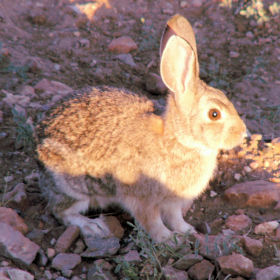
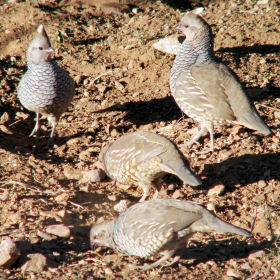 small mammals such as prairie dogs, rabbits, badgers, and many birds including 2 species of Quail. Mountain lion and desert bighorn sheep may be seen at the higher elevations of the
Florida Mountains. Ibex, wild goats originally shipped from Iran, can be seen here as well. A variety of plants thrive in this environment, including yucca, prickly pear cactus, barrel cactus, ocotillo, creosote bush, mesquite, and hackberry. Juniper and scrub oak are common in the canyons.
small mammals such as prairie dogs, rabbits, badgers, and many birds including 2 species of Quail. Mountain lion and desert bighorn sheep may be seen at the higher elevations of the
Florida Mountains. Ibex, wild goats originally shipped from Iran, can be seen here as well. A variety of plants thrive in this environment, including yucca, prickly pear cactus, barrel cactus, ocotillo, creosote bush, mesquite, and hackberry. Juniper and scrub oak are common in the canyons.
 Gray perlite, thundereggs, geodes, jasper, onyx, agate, crystalline rhyolite, Apache tears (obsidian), and quartz crystals are among the more common rocks and minerals found in the park. Agate is present in a wide range of colors and is one of the minerals that many visitors collect at Rockhound State Park. Some thundereggs and geodes found at Rockhound contain multicolored agate in addition to well-formed quartz crystals.
Gray perlite, thundereggs, geodes, jasper, onyx, agate, crystalline rhyolite, Apache tears (obsidian), and quartz crystals are among the more common rocks and minerals found in the park. Agate is present in a wide range of colors and is one of the minerals that many visitors collect at Rockhound State Park. Some thundereggs and geodes found at Rockhound contain multicolored agate in addition to well-formed quartz crystals.
Columbus, New Mexico
10/25/07

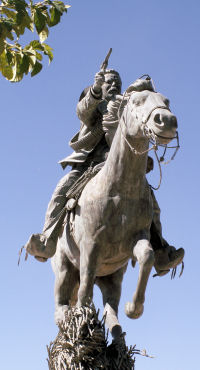
David and JoEllen spend a day sightseeing and visiting Columbus, New Mexico and Polamas, Mexico. Columbus is the site of the only invasion of the American homeland. In 1916, Pancho Villa and his band of Mexican Army misfits raided the town and army base located here, killing civilians and U.S. soldiers. At Pancho Villa State Park, there is a wonderful mueseum filled with artifacts and replicas of equipment and vehicles used by the army in the early 20th century.
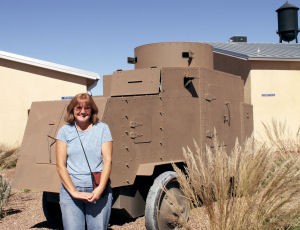
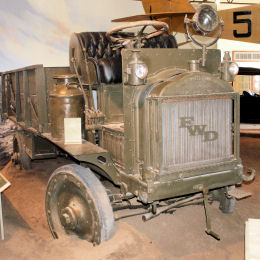 This is also the site of the first American Air Corps.
In 1916 America lagged far behind Europe in developing aircraft suitable for military operations. The eight IN-3 Curtiss biplanes or "Jennies", shipped to Columbus by train and assembled on site consituted the nation's air corps. Due to their fragile nature, the harsh desert conditions, altitude problems, and untested pilots, all of these Jennies were shortly damaged or destroyed.
This is also the site of the first American Air Corps.
In 1916 America lagged far behind Europe in developing aircraft suitable for military operations. The eight IN-3 Curtiss biplanes or "Jennies", shipped to Columbus by train and assembled on site consituted the nation's air corps. Due to their fragile nature, the harsh desert conditions, altitude problems, and untested pilots, all of these Jennies were shortly damaged or destroyed.
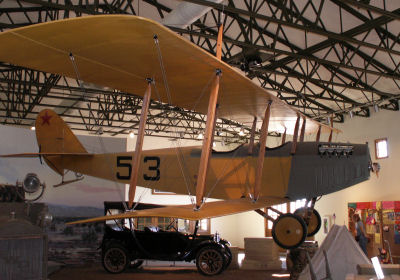 They were quickly replaced by a variety of new aircraft. The new JN-4 Jenny proved more reliable and was used during the invasion of Mexico. Over 6000 were eventually built, some surviving into the 1930's as the classic barnstorming biplane.
The American aircorps developed rapidly under fire. Between March 15 and August 15, 1916, approximately one-hundred men, the first entirely motorized unit in the U.S. Army, survived remarkable hardship and danger to fly or support 540 missions chasing Pancho Villa in Mexico.
They were quickly replaced by a variety of new aircraft. The new JN-4 Jenny proved more reliable and was used during the invasion of Mexico. Over 6000 were eventually built, some surviving into the 1930's as the classic barnstorming biplane.
The American aircorps developed rapidly under fire. Between March 15 and August 15, 1916, approximately one-hundred men, the first entirely motorized unit in the U.S. Army, survived remarkable hardship and danger to fly or support 540 missions chasing Pancho Villa in Mexico.

